light FORD SIERRA 1992 2.G CVH Engines Workshop Manual
[x] Cancel search | Manufacturer: FORD, Model Year: 1992, Model line: SIERRA, Model: FORD SIERRA 1992 2.GPages: 24, PDF Size: 1.09 MB
Page 5 of 24
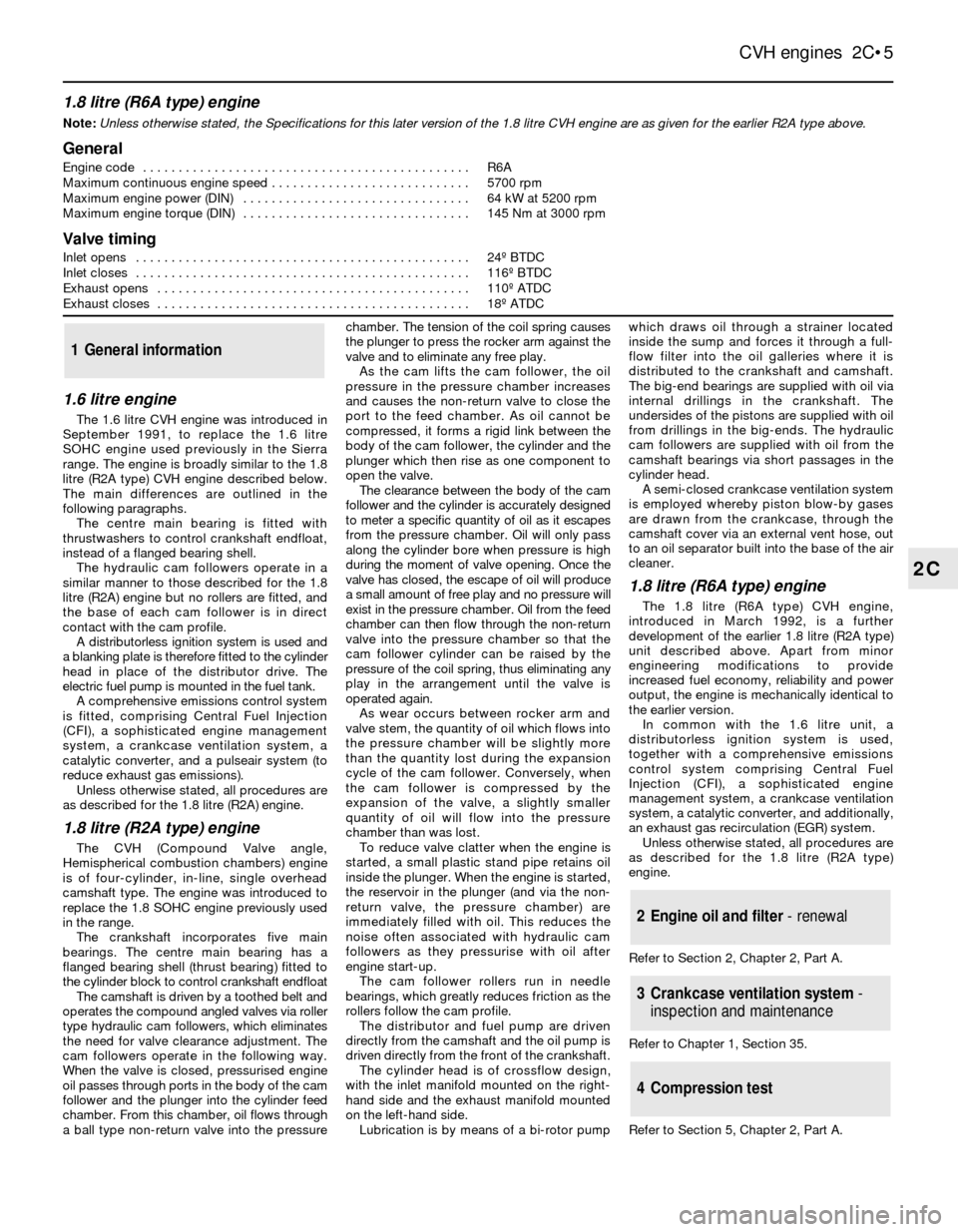
1.8 litre (R6A type) engine
Note: Unless otherwise stated, the Specifications for this later version of the 1.8 litre CVH engine are as given for the earlier R2A type above.
General
Engine code . . . . . . . . . . . . . . . . . . . . . . . . . . . . . . . . . . . . . . . . . . . . . .R6A
Maximum continuous engine speed . . . . . . . . . . . . . . . . . . . . . . . . . . . .5700 rpm
Maximum engine power (DIN) . . . . . . . . . . . . . . . . . . . . . . . . . . . . . . . .64 kW at 5200 rpm
Maximum engine torque (DIN) . . . . . . . . . . . . . . . . . . . . . . . . . . . . . . . .145 Nm at 3000 rpm
Valve timing
Inlet opens . . . . . . . . . . . . . . . . . . . . . . . . . . . . . . . . . . . . . . . . . . . . . . .24º BTDC
Inlet closes . . . . . . . . . . . . . . . . . . . . . . . . . . . . . . . . . . . . . . . . . . . . . . .116º BTDC
Exhaust opens . . . . . . . . . . . . . . . . . . . . . . . . . . . . . . . . . . . . . . . . . . . .110º ATDC
Exhaust closes . . . . . . . . . . . . . . . . . . . . . . . . . . . . . . . . . . . . . . . . . . . .18º ATDC
1.6 litre engine
The 1.6 litre CVH engine was introduced in
September 1991, to replace the 1.6 litre
SOHC engine used previously in the Sierra
range. The engine is broadly similar to the 1.8
litre (R2A type) CVH engine described below.
The main differences are outlined in the
following paragraphs.
The centre main bearing is fitted with
thrustwashers to control crankshaft endfloat,
instead of a flanged bearing shell.
The hydraulic cam followers operate in a
similar manner to those described for the 1.8
litre (R2A) engine but no rollers are fitted, and
the base of each cam follower is in direct
contact with the cam profile.
A distributorless ignition system is used and
a blanking plate is therefore fitted to the cylinder
head in place of the distributor drive. The
electric fuel pump is mounted in the fuel tank.
A comprehensive emissions control system
is fitted, comprising Central Fuel Injection
(CFI), a sophisticated engine management
system, a crankcase ventilation system, a
catalytic converter, and a pulseair system (to
reduce exhaust gas emissions).
Unless otherwise stated, all procedures are
as described for the 1.8 litre (R2A) engine.
1.8 litre (R2A type) engine
The CVH (Compound Valve angle,
Hemispherical combustion chambers) engine
is of four-cylinder, in-line, single overhead
camshaft type. The engine was introduced to
replace the 1.8 SOHC engine previously used
in the range.
The crankshaft incorporates five main
bearings. The centre main bearing has a
flanged bearing shell (thrust bearing) fitted to
the cylinder block to control crankshaft endfloat
The camshaft is driven by a toothed belt and
operates the compound angled valves via roller
type hydraulic cam followers, which eliminates
the need for valve clearance adjustment. The
cam followers operate in the following way.
When the valve is closed, pressurised engine
oil passes through ports in the body of the cam
follower and the plunger into the cylinder feed
chamber. From this chamber, oil flows through
a ball type non-return valve into the pressurechamber. The tension of the coil spring causes
the plunger to press the rocker arm against the
valve and to eliminate any free play.
As the cam lifts the cam follower, the oil
pressure in the pressure chamber increases
and causes the non-return valve to close the
port to the feed chamber. As oil cannot be
compressed, it forms a rigid link between the
body of the cam follower, the cylinder and the
plunger which then rise as one component to
open the valve.
The clearance between the body of the cam
follower and the cylinder is accurately designed
to meter a specific quantity of oil as it escapes
from the pressure chamber. Oil will only pass
along the cylinder bore when pressure is high
during the moment of valve opening. Once the
valve has closed, the escape of oil will produce
a small amount of free play and no pressure will
exist in the pressure chamber. Oil from the feed
chamber can then flow through the non-return
valve into the pressure chamber so that the
cam follower cylinder can be raised by the
pressure of the coil spring, thus eliminating any
play in the arrangement until the valve is
operated again.
As wear occurs between rocker arm and
valve stem, the quantity of oil which flows into
the pressure chamber will be slightly more
than the quantity lost during the expansion
cycle of the cam follower. Conversely, when
the cam follower is compressed by the
expansion of the valve, a slightly smaller
quantity of oil will flow into the pressure
chamber than was lost.
To reduce valve clatter when the engine is
started, a small plastic stand pipe retains oil
inside the plunger. When the engine is started,
the reservoir in the plunger (and via the non-
return valve, the pressure chamber) are
immediately filled with oil. This reduces the
noise often associated with hydraulic cam
followers as they pressurise with oil after
engine start-up.
The cam follower rollers run in needle
bearings, which greatly reduces friction as the
rollers follow the cam profile.
The distributor and fuel pump are driven
directly from the camshaft and the oil pump is
driven directly from the front of the crankshaft.
The cylinder head is of crossflow design,
with the inlet manifold mounted on the right-
hand side and the exhaust manifold mounted
on the left-hand side.
Lubrication is by means of a bi-rotor pumpwhich draws oil through a strainer located
inside the sump and forces it through a full-
flow filter into the oil galleries where it is
distributed to the crankshaft and camshaft.
The big-end bearings are supplied with oil via
internal drillings in the crankshaft. The
undersides of the pistons are supplied with oil
from drillings in the big-ends. The hydraulic
cam followers are supplied with oil from the
camshaft bearings via short passages in the
cylinder head.
A semi-closed crankcase ventilation system
is employed whereby piston blow-by gases
are drawn from the crankcase, through the
camshaft cover via an external vent hose, out
to an oil separator built into the base of the air
cleaner.
1.8 litre (R6A type) engine
The 1.8 litre (R6A type) CVH engine,
introduced in March 1992, is a further
development of the earlier 1.8 litre (R2A type)
unit described above. Apart from minor
engineering modifications to provide
increased fuel economy, reliability and power
output, the engine is mechanically identical to
the earlier version.
In common with the 1.6 litre unit, a
distributorless ignition system is used,
together with a comprehensive emissions
control system comprising Central Fuel
Injection (CFI), a sophisticated engine
management system, a crankcase ventilation
system, a catalytic converter, and additionally,
an exhaust gas recirculation (EGR) system.
Unless otherwise stated, all procedures are
as described for the 1.8 litre (R2A type)
engine.
Refer to Section 2, Chapter 2, Part A.
Refer to Chapter 1, Section 35.
Refer to Section 5, Chapter 2, Part A.
4Compression test
3Crankcase ventilation system -
inspection and maintenance
2Engine oil and filter - renewal
1General information
CVH engines 2C•5
2C
Page 8 of 24
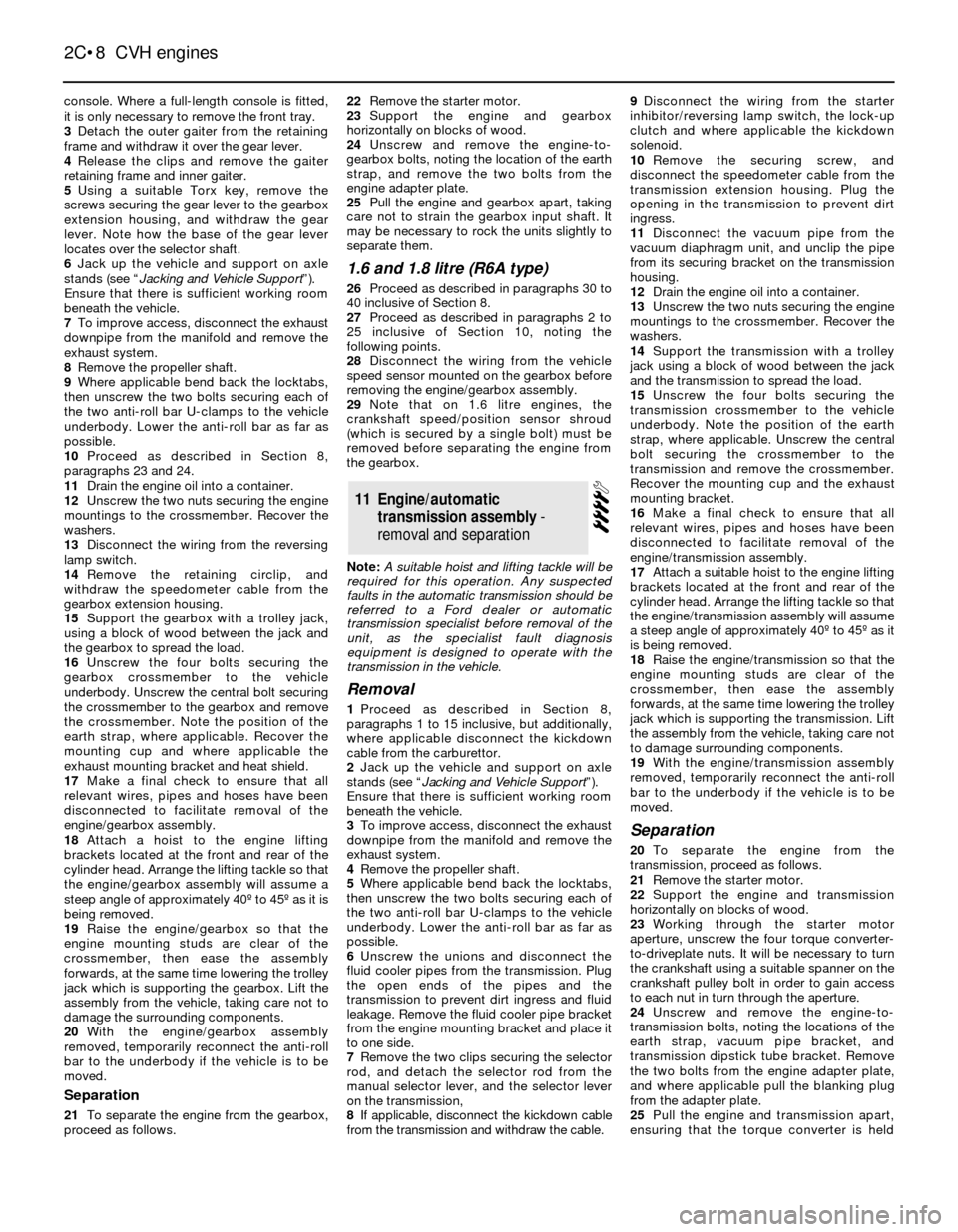
console. Where a full-length console is fitted,
it is only necessary to remove the front tray.
3Detach the outer gaiter from the retaining
frame and withdraw it over the gear lever.
4Release the clips and remove the gaiter
retaining frame and inner gaiter.
5Using a suitable Torx key, remove the
screws securing the gear lever to the gearbox
extension housing, and withdraw the gear
lever. Note how the base of the gear lever
locates over the selector shaft.
6Jack up the vehicle and support on axle
stands (see “Jacking and Vehicle Support”).
Ensure that there is sufficient working room
beneath the vehicle.
7To improve access, disconnect the exhaust
downpipe from the manifold and remove the
exhaust system.
8Remove the propeller shaft.
9Where applicable bend back the locktabs,
then unscrew the two bolts securing each of
the two anti-roll bar U-clamps to the vehicle
underbody. Lower the anti-roll bar as far as
possible.
10Proceed as described in Section 8,
paragraphs 23 and 24.
11Drain the engine oil into a container.
12Unscrew the two nuts securing the engine
mountings to the crossmember. Recover the
washers.
13Disconnect the wiring from the reversing
lamp switch.
14Remove the retaining circlip, and
withdraw the speedometer cable from the
gearbox extension housing.
15Support the gearbox with a trolley jack,
using a block of wood between the jack and
the gearbox to spread the load.
16Unscrew the four bolts securing the
gearbox crossmember to the vehicle
underbody. Unscrew the central bolt securing
the crossmember to the gearbox and remove
the crossmember. Note the position of the
earth strap, where applicable. Recover the
mounting cup and where applicable the
exhaust mounting bracket and heat shield.
17Make a final check to ensure that all
relevant wires, pipes and hoses have been
disconnected to facilitate removal of the
engine/gearbox assembly.
18Attach a hoist to the engine lifting
brackets located at the front and rear of the
cylinder head. Arrange the lifting tackle so that
the engine/gearbox assembly will assume a
steep angle of approximately 40º to 45º as it is
being removed.
19Raise the engine/gearbox so that the
engine mounting studs are clear of the
crossmember, then ease the assembly
forwards, at the same time lowering the trolley
jack which is supporting the gearbox. Lift the
assembly from the vehicle, taking care not to
damage the surrounding components.
20With the engine/gearbox assembly
removed, temporarily reconnect the anti-roll
bar to the underbody if the vehicle is to be
moved.
Separation
21To separate the engine from the gearbox,
proceed as follows. 22Remove the starter motor.
23Support the engine and gearbox
horizontally on blocks of wood.
24Unscrew and remove the engine-to-
gearbox bolts, noting the location of the earth
strap, and remove the two bolts from the
engine adapter plate.
25Pull the engine and gearbox apart, taking
care not to strain the gearbox input shaft. It
may be necessary to rock the units slightly to
separate them.
1.6 and 1.8 litre (R6A type)
26Proceed as described in paragraphs 30 to
40 inclusive of Section 8.
27Proceed as described in paragraphs 2 to
25 inclusive of Section 10, noting the
following points.
28Disconnect the wiring from the vehicle
speed sensor mounted on the gearbox before
removing the engine/gearbox assembly.
29Note that on 1.6 litre engines, the
crankshaft speed/position sensor shroud
(which is secured by a single bolt) must be
removed before separating the engine from
the gearbox.
Note: A suitable hoist and lifting tackle will be
required for this operation. Any suspected
faults in the automatic transmission should be
referred to a Ford dealer or automatic
transmission specialist before removal of the
unit, as the specialist fault diagnosis
equipment is designed to operate with the
transmission in the vehicle.
Removal
1Proceed as described in Section 8,
paragraphs 1 to 15 inclusive, but additionally,
where applicable disconnect the kickdown
cable from the carburettor.
2Jack up the vehicle and support on axle
stands (see “Jacking and Vehicle Support”).
Ensure that there is sufficient working room
beneath the vehicle.
3To improve access, disconnect the exhaust
downpipe from the manifold and remove the
exhaust system.
4Remove the propeller shaft.
5Where applicable bend back the locktabs,
then unscrew the two bolts securing each of
the two anti-roll bar U-clamps to the vehicle
underbody. Lower the anti-roll bar as far as
possible.
6Unscrew the unions and disconnect the
fluid cooler pipes from the transmission. Plug
the open ends of the pipes and the
transmission to prevent dirt ingress and fluid
leakage. Remove the fluid cooler pipe bracket
from the engine mounting bracket and place it
to one side.
7Remove the two clips securing the selector
rod, and detach the selector rod from the
manual selector lever, and the selector lever
on the transmission,
8If applicable, disconnect the kickdown cable
from the transmission and withdraw the cable.9Disconnect the wiring from the starter
inhibitor/reversing lamp switch, the lock-up
clutch and where applicable the kickdown
solenoid.
10Remove the securing screw, and
disconnect the speedometer cable from the
transmission extension housing. Plug the
opening in the transmission to prevent dirt
ingress.
11Disconnect the vacuum pipe from the
vacuum diaphragm unit, and unclip the pipe
from its securing bracket on the transmission
housing.
12Drain the engine oil into a container.
13Unscrew the two nuts securing the engine
mountings to the crossmember. Recover the
washers.
14Support the transmission with a trolley
jack using a block of wood between the jack
and the transmission to spread the load.
15Unscrew the four bolts securing the
transmission crossmember to the vehicle
underbody. Note the position of the earth
strap, where applicable. Unscrew the central
bolt securing the crossmember to the
transmission and remove the crossmember.
Recover the mounting cup and the exhaust
mounting bracket.
16Make a final check to ensure that all
relevant wires, pipes and hoses have been
disconnected to facilitate removal of the
engine/transmission assembly.
17Attach a suitable hoist to the engine lifting
brackets located at the front and rear of the
cylinder head. Arrange the lifting tackle so that
the engine/transmission assembly will assume
a steep angle of approximately 40º to 45º as it
is being removed.
18Raise the engine/transmission so that the
engine mounting studs are clear of the
crossmember, then ease the assembly
forwards, at the same time lowering the trolley
jack which is supporting the transmission. Lift
the assembly from the vehicle, taking care not
to damage surrounding components.
19With the engine/transmission assembly
removed, temporarily reconnect the anti-roll
bar to the underbody if the vehicle is to be
moved.
Separation
20To separate the engine from the
transmission, proceed as follows.
21Remove the starter motor.
22Support the engine and transmission
horizontally on blocks of wood.
23Working through the starter motor
aperture, unscrew the four torque converter-
to-driveplate nuts. It will be necessary to turn
the crankshaft using a suitable spanner on the
crankshaft pulley bolt in order to gain access
to each nut in turn through the aperture.
24Unscrew and remove the engine-to-
transmission bolts, noting the locations of the
earth strap, vacuum pipe bracket, and
transmission dipstick tube bracket. Remove
the two bolts from the engine adapter plate,
and where applicable pull the blanking plug
from the adapter plate.
25Pull the engine and transmission apart,
ensuring that the torque converter is held
11Engine/automatic
transmission assembly -
removal and separation
2C•8CVH engines
Page 9 of 24
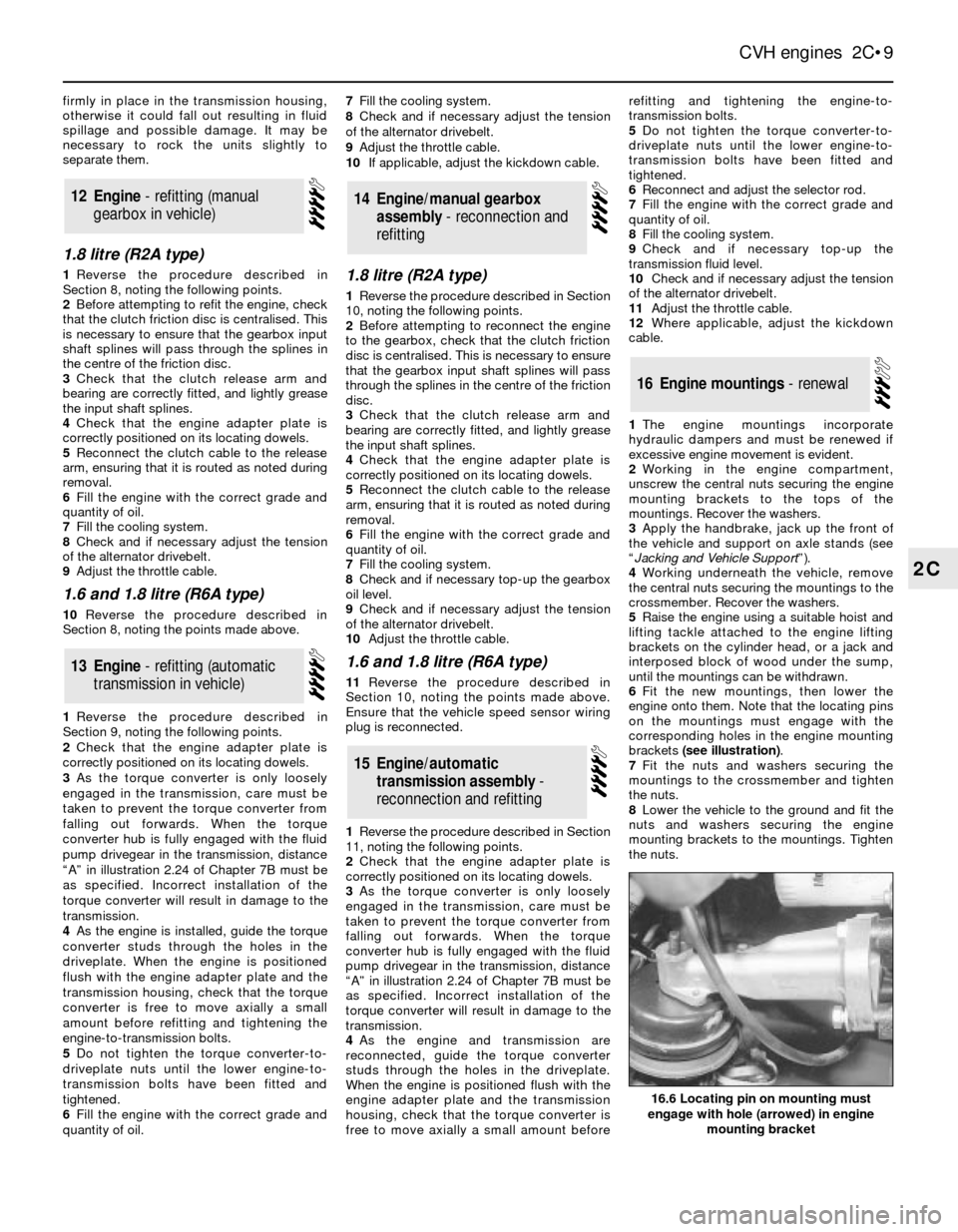
firmly in place in the transmission housing,
otherwise it could fall out resulting in fluid
spillage and possible damage. It may be
necessary to rock the units slightly to
separate them.
1.8 litre (R2A type)
1Reverse the procedure described in
Section 8, noting the following points.
2Before attempting to refit the engine, check
that the clutch friction disc is centralised. This
is necessary to ensure that the gearbox input
shaft splines will pass through the splines in
the centre of the friction disc.
3Check that the clutch release arm and
bearing are correctly fitted, and lightly grease
the input shaft splines.
4Check that the engine adapter plate is
correctly positioned on its locating dowels.
5Reconnect the clutch cable to the release
arm, ensuring that it is routed as noted during
removal.
6Fill the engine with the correct grade and
quantity of oil.
7Fill the cooling system.
8Check and if necessary adjust the tension
of the alternator drivebelt.
9Adjust the throttle cable.
1.6 and 1.8 litre (R6A type)
10Reverse the procedure described in
Section 8, noting the points made above.
1Reverse the procedure described in
Section 9, noting the following points.
2Check that the engine adapter plate is
correctly positioned on its locating dowels.
3As the torque converter is only loosely
engaged in the transmission, care must be
taken to prevent the torque converter from
falling out forwards. When the torque
converter hub is fully engaged with the fluid
pump drivegear in the transmission, distance
“A” in illustration 2.24 of Chapter 7B must be
as specified. Incorrect installation of the
torque converter will result in damage to the
transmission.
4As the engine is installed, guide the torque
converter studs through the holes in the
driveplate. When the engine is positioned
flush with the engine adapter plate and the
transmission housing, check that the torque
converter is free to move axially a small
amount before refitting and tightening the
engine-to-transmission bolts.
5Do not tighten the torque converter-to-
driveplate nuts until the lower engine-to-
transmission bolts have been fitted and
tightened.
6Fill the engine with the correct grade and
quantity of oil. 7Fill the cooling system.
8Check and if necessary adjust the tension
of the alternator drivebelt.
9Adjust the throttle cable.
10If applicable, adjust the kickdown cable.
1.8 litre (R2A type)
1Reverse the procedure described in Section
10, noting the following points.
2Before attempting to reconnect the engine
to the gearbox, check that the clutch friction
disc is centralised. This is necessary to ensure
that the gearbox input shaft splines will pass
through the splines in the centre of the friction
disc.
3Check that the clutch release arm and
bearing are correctly fitted, and lightly grease
the input shaft splines.
4Check that the engine adapter plate is
correctly positioned on its locating dowels.
5Reconnect the clutch cable to the release
arm, ensuring that it is routed as noted during
removal.
6Fill the engine with the correct grade and
quantity of oil.
7Fill the cooling system.
8Check and if necessary top-up the gearbox
oil level.
9Check and if necessary adjust the tension
of the alternator drivebelt.
10Adjust the throttle cable.
1.6 and 1.8 litre (R6A type)
11Reverse the procedure described in
Section 10, noting the points made above.
Ensure that the vehicle speed sensor wiring
plug is reconnected.
1Reverse the procedure described in Section
11, noting the following points.
2Check that the engine adapter plate is
correctly positioned on its locating dowels.
3As the torque converter is only loosely
engaged in the transmission, care must be
taken to prevent the torque converter from
falling out forwards. When the torque
converter hub is fully engaged with the fluid
pump drivegear in the transmission, distance
“A” in illustration 2.24 of Chapter 7B must be
as specified. Incorrect installation of the
torque converter will result in damage to the
transmission.
4As the engine and transmission are
reconnected, guide the torque converter
studs through the holes in the driveplate.
When the engine is positioned flush with the
engine adapter plate and the transmission
housing, check that the torque converter is
free to move axially a small amount beforerefitting and tightening the engine-to-
transmission bolts.
5Do not tighten the torque converter-to-
driveplate nuts until the lower engine-to-
transmission bolts have been fitted and
tightened.
6Reconnect and adjust the selector rod.
7Fill the engine with the correct grade and
quantity of oil.
8Fill the cooling system.
9Check and if necessary top-up the
transmission fluid level.
10Check and if necessary adjust the tension
of the alternator drivebelt.
11Adjust the throttle cable.
12Where applicable, adjust the kickdown
cable.
1The engine mountings incorporate
hydraulic dampers and must be renewed if
excessive engine movement is evident.
2Working in the engine compartment,
unscrew the central nuts securing the engine
mounting brackets to the tops of the
mountings. Recover the washers.
3Apply the handbrake, jack up the front of
the vehicle and support on axle stands (see
“Jacking and Vehicle Support”).
4Working underneath the vehicle, remove
the central nuts securing the mountings to the
crossmember. Recover the washers.
5Raise the engine using a suitable hoist and
lifting tackle attached to the engine lifting
brackets on the cylinder head, or a jack and
interposed block of wood under the sump,
until the mountings can be withdrawn.
6Fit the new mountings, then lower the
engine onto them. Note that the locating pins
on the mountings must engage with the
corresponding holes in the engine mounting
brackets (see illustration).
7Fit the nuts and washers securing the
mountings to the crossmember and tighten
the nuts.
8Lower the vehicle to the ground and fit the
nuts and washers securing the engine
mounting brackets to the mountings. Tighten
the nuts.
16Engine mountings - renewal
15Engine/automatic
transmission assembly -
reconnection and refitting
14Engine/manual gearbox
assembly - reconnection and
refitting
13Engine - refitting (automatic
transmission in vehicle)
12Engine - refitting (manual
gearbox in vehicle)
CVH engines 2C•9
2C
16.6 Locating pin on mounting must
engage with hole (arrowed) in engine
mounting bracket
Page 19 of 24
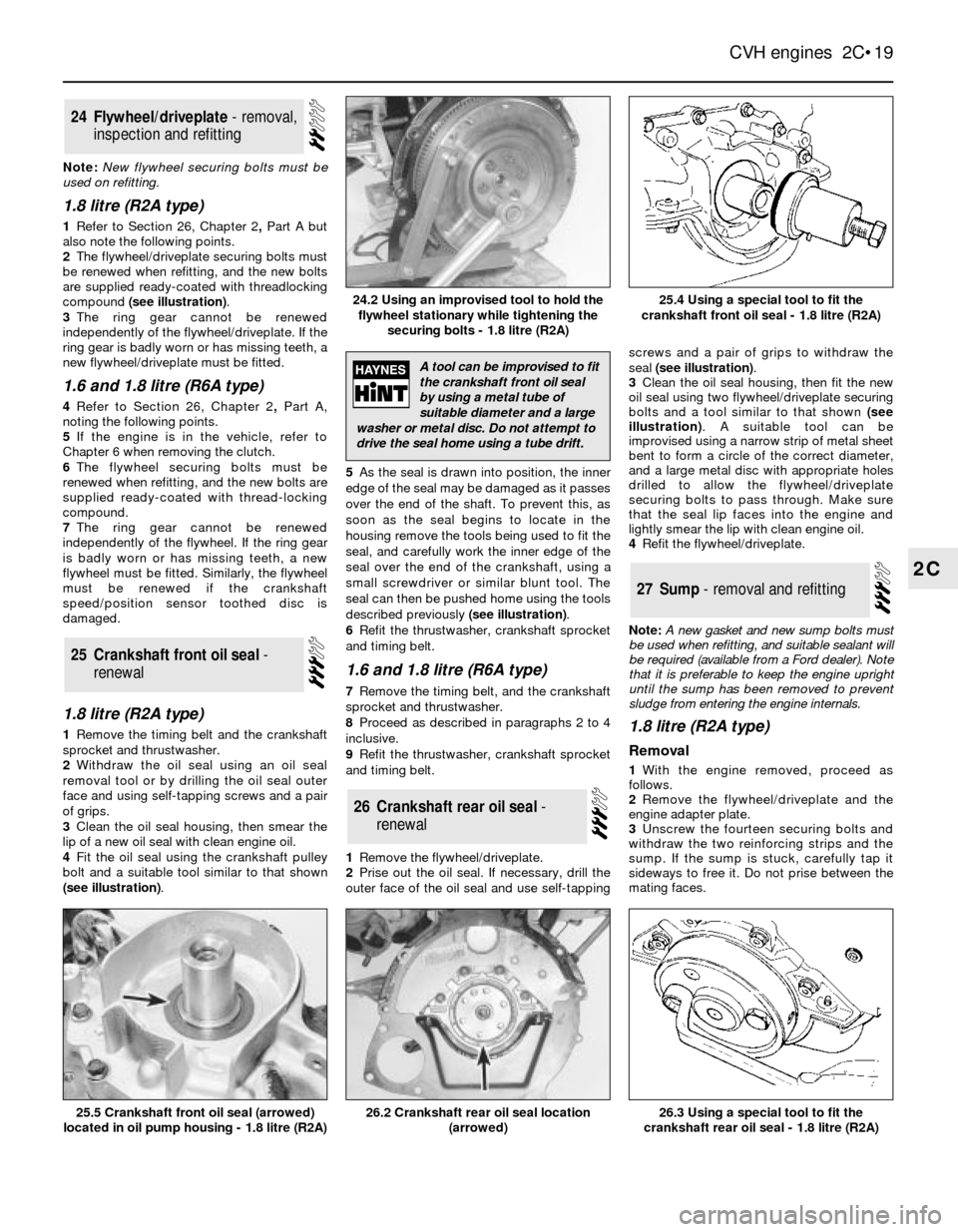
Note: New flywheel securing bolts must be
used on refitting.
1.8 litre (R2A type)
1Refer to Section 26, Chapter 2, PartA but
also note the following points.
2The flywheel/driveplate securing bolts must
be renewed when refitting, and the new bolts
are supplied ready-coated with threadlocking
compound (see illustration).
3The ring gear cannot be renewed
independently of the flywheel/driveplate. If the
ring gear is badly worn or has missing teeth, a
new flywheel/driveplate must be fitted.
1.6 and 1.8 litre (R6A type)
4Refer to Section 26, Chapter 2, PartA,
noting the following points.
5If the engine is in the vehicle, refer to
Chapter 6 when removing the clutch.
6The flywheel securing bolts must be
renewed when refitting, and the new bolts are
supplied ready-coated with thread-locking
compound.
7The ring gear cannot be renewed
independently of the flywheel. If the ring gear
is badly worn or has missing teeth, a new
flywheel must be fitted. Similarly, the flywheel
must be renewed if the crankshaft
speed/position sensor toothed disc is
damaged.
1.8 litre (R2A type)
1Remove the timing belt and the crankshaft
sprocket and thrustwasher.
2Withdraw the oil seal using an oil seal
removal tool or by drilling the oil seal outer
face and using self-tapping screws and a pair
of grips.
3Clean the oil seal housing, then smear the
lip of a new oil seal with clean engine oil.
4Fit the oil seal using the crankshaft pulley
bolt and a suitable tool similar to that shown
(see illustration).5As the seal is drawn into position, the inner
edge of the seal may be damaged as it passes
over the end of the shaft. To prevent this, as
soon as the seal begins to locate in the
housing remove the tools being used to fit the
seal, and carefully work the inner edge of the
seal over the end of the crankshaft, using a
small screwdriver or similar blunt tool. The
seal can then be pushed home using the tools
described previously (see illustration).
6Refit the thrustwasher, crankshaft sprocket
and timing belt.
1.6 and 1.8 litre (R6A type)
7Remove the timing belt, and the crankshaft
sprocket and thrustwasher.
8Proceed as described in paragraphs 2 to 4
inclusive.
9Refit the thrustwasher, crankshaft sprocket
and timing belt.
1Remove the flywheel/driveplate.
2Prise out the oil seal. If necessary, drill the
outer face of the oil seal and use self-tappingscrews and a pair of grips to withdraw the
seal (see illustration).
3Clean the oil seal housing, then fit the new
oil seal using two flywheel/driveplate securing
bolts and a tool similar to that shown (see
illustration). A suitable tool can be
improvised using a narrow strip of metal sheet
bent to form a circle of the correct diameter,
and a large metal disc with appropriate holes
drilled to allow the flywheel/driveplate
securing bolts to pass through. Make sure
that the seal lip faces into the engine and
lightly smear the lip with clean engine oil.
4Refit the flywheel/driveplate.
Note: A new gasket and new sump bolts must
be used when refitting, and suitable sealant will
be required (available from a Ford dealer). Note
that it is preferable to keep the engine upright
until the sump has been removed to prevent
sludge from entering the engine internals.
1.8 litre (R2A type)
Removal
1With the engine removed, proceed as
follows.
2Remove the flywheel/driveplate and the
engine adapter plate.
3Unscrew the fourteen securing bolts and
withdraw the two reinforcing strips and the
sump. If the sump is stuck, carefully tap it
sideways to free it. Do not prise between the
mating faces.
27Sump - removal and refitting
26Crankshaft rear oil seal -
renewal
25Crankshaft front oil seal -
renewal
24Flywheel/driveplate - removal,
inspection and refitting
CVH engines 2C•19
2C
25.5 Crankshaft front oil seal (arrowed)
located in oil pump housing - 1.8 litre (R2A)26.3 Using a special tool to fit the
crankshaft rear oil seal - 1.8 litre (R2A)26.2 Crankshaft rear oil seal location
(arrowed)
25.4 Using a special tool to fit the
crankshaft front oil seal - 1.8 litre (R2A)24.2 Using an improvised tool to hold the
flywheel stationary while tightening the
securing bolts - 1.8 litre (R2A)
A tool can be improvised to fit
the crankshaft front oil seal
by using a metal tube of
suitable diameter and a large
washer or metal disc. Do not attempt to
drive the seal home using a tube drift.
Page 20 of 24
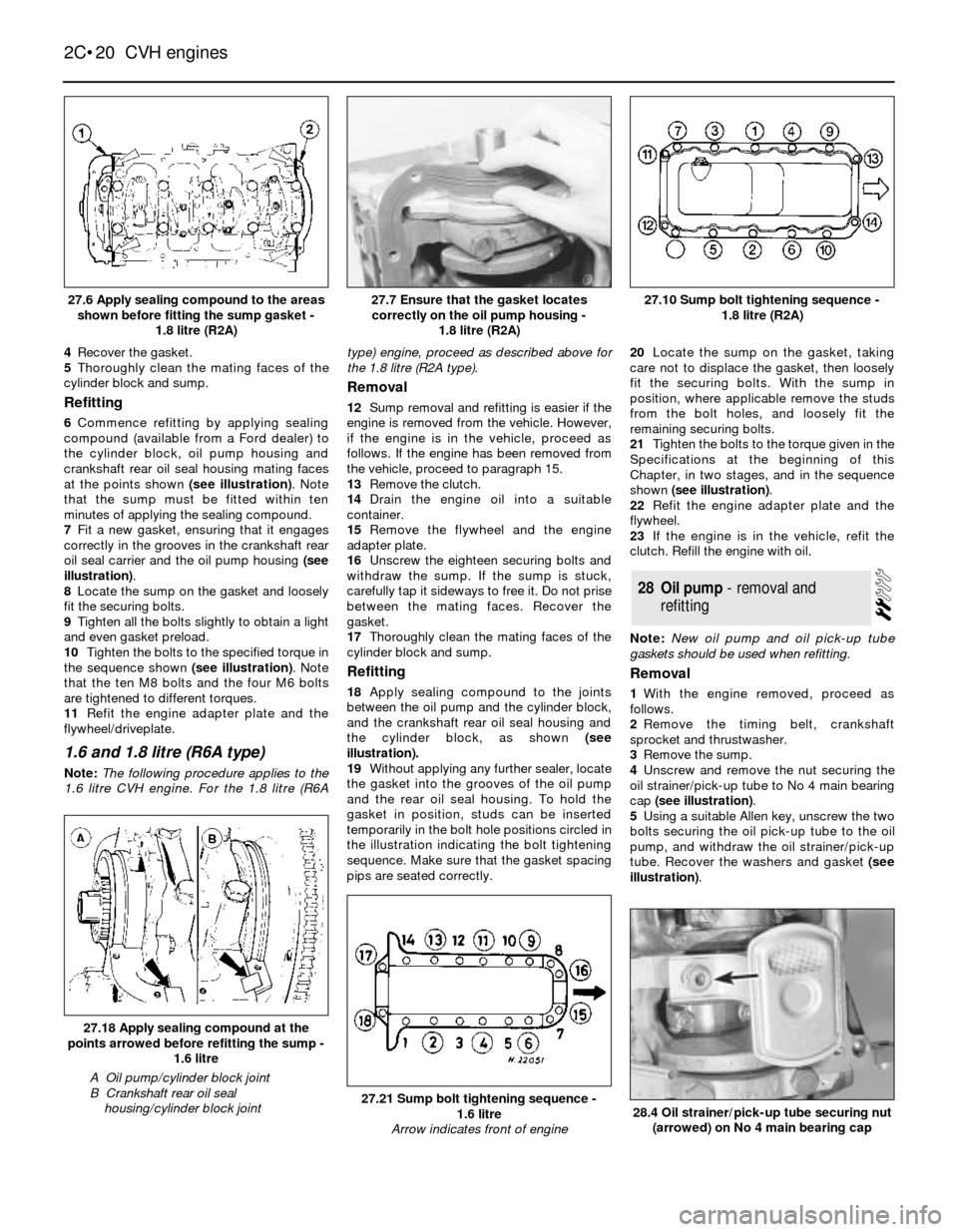
4Recover the gasket.
5Thoroughly clean the mating faces of the
cylinder block and sump.
Refitting
6Commence refitting by applying sealing
compound (available from a Ford dealer) to
the cylinder block, oil pump housing and
crankshaft rear oil seal housing mating faces
at the points shown (see illustration). Note
that the sump must be fitted within ten
minutes of applying the sealing compound.
7Fit a new gasket, ensuring that it engages
correctly in the grooves in the crankshaft rear
oil seal carrier and the oil pump housing (see
illustration).
8Locate the sump on the gasket and loosely
fit the securing bolts.
9Tighten all the bolts slightly to obtain a light
and even gasket preload.
10Tighten the bolts to the specified torque in
the sequence shown (see illustration). Note
that the ten M8 bolts and the four M6 bolts
are tightened to different torques.
11Refit the engine adapter plate and the
flywheel/driveplate.
1.6 and 1.8 litre (R6A type)
Note: The following procedure applies to the
1.6 litre CVH engine. For the 1.8 litre (R6Atype) engine, proceed as described above for
the 1.8 litre (R2A type).
Removal
12Sump removal and refitting is easier if the
engine is removed from the vehicle. However,
if the engine is in the vehicle, proceed as
follows. If the engine has been removed from
the vehicle, proceed to paragraph 15.
13Remove the clutch.
14Drain the engine oil into a suitable
container.
15Remove the flywheel and the engine
adapter plate.
16Unscrew the eighteen securing bolts and
withdraw the sump. If the sump is stuck,
carefully tap it sideways to free it. Do not prise
between the mating faces. Recover the
gasket.
17Thoroughly clean the mating faces of the
cylinder block and sump.
Refitting
18Apply sealing compound to the joints
between the oil pump and the cylinder block,
and the crankshaft rear oil seal housing and
the cylinder block, as shown (see
illustration).
19Without applying any further sealer, locate
the gasket into the grooves of the oil pump
and the rear oil seal housing. To hold the
gasket in position, studs can be inserted
temporarily in the bolt hole positions circled in
the illustration indicating the bolt tightening
sequence. Make sure that the gasket spacing
pips are seated correctly.20Locate the sump on the gasket, taking
care not to displace the gasket, then loosely
fit the securing bolts. With the sump in
position, where applicable remove the studs
from the bolt holes, and loosely fit the
remaining securing bolts.
21Tighten the bolts to the torque given in the
Specifications at the beginning of this
Chapter, in two stages, and in the sequence
shown (see illustration).
22Refit the engine adapter plate and the
flywheel.
23If the engine is in the vehicle, refit the
clutch. Refill the engine with oil.
Note: New oil pump and oil pick-up tube
gaskets should be used when refitting.
Removal
1With the engine removed, proceed as
follows.
2Remove the timing belt, crankshaft
sprocket and thrustwasher.
3Remove the sump.
4Unscrew and remove the nut securing the
oil strainer/pick-up tube to No 4 main bearing
cap (see illustration).
5Using a suitable Allen key, unscrew the two
bolts securing the oil pick-up tube to the oil
pump, and withdraw the oil strainer/pick-up
tube. Recover the washers and gasket (see
illustration).
28Oil pump - removal and
refitting
2C•20CVH engines
27.6 Apply sealing compound to the areas
shown before fitting the sump gasket -
1.8 litre (R2A)27.10 Sump bolt tightening sequence -
1.8 litre (R2A)
27.21 Sump bolt tightening sequence -
1.6 litre
Arrow indicates front of engine
27.18 Apply sealing compound at the
points arrowed before refitting the sump -
1.6 litre
A Oil pump/cylinder block joint
B Crankshaft rear oil seal
housing/cylinder block joint
27.7 Ensure that the gasket locates
correctly on the oil pump housing -
1.8 litre (R2A)
28.4 Oil strainer/pick-up tube securing nut
(arrowed) on No 4 main bearing cap
Page 23 of 24
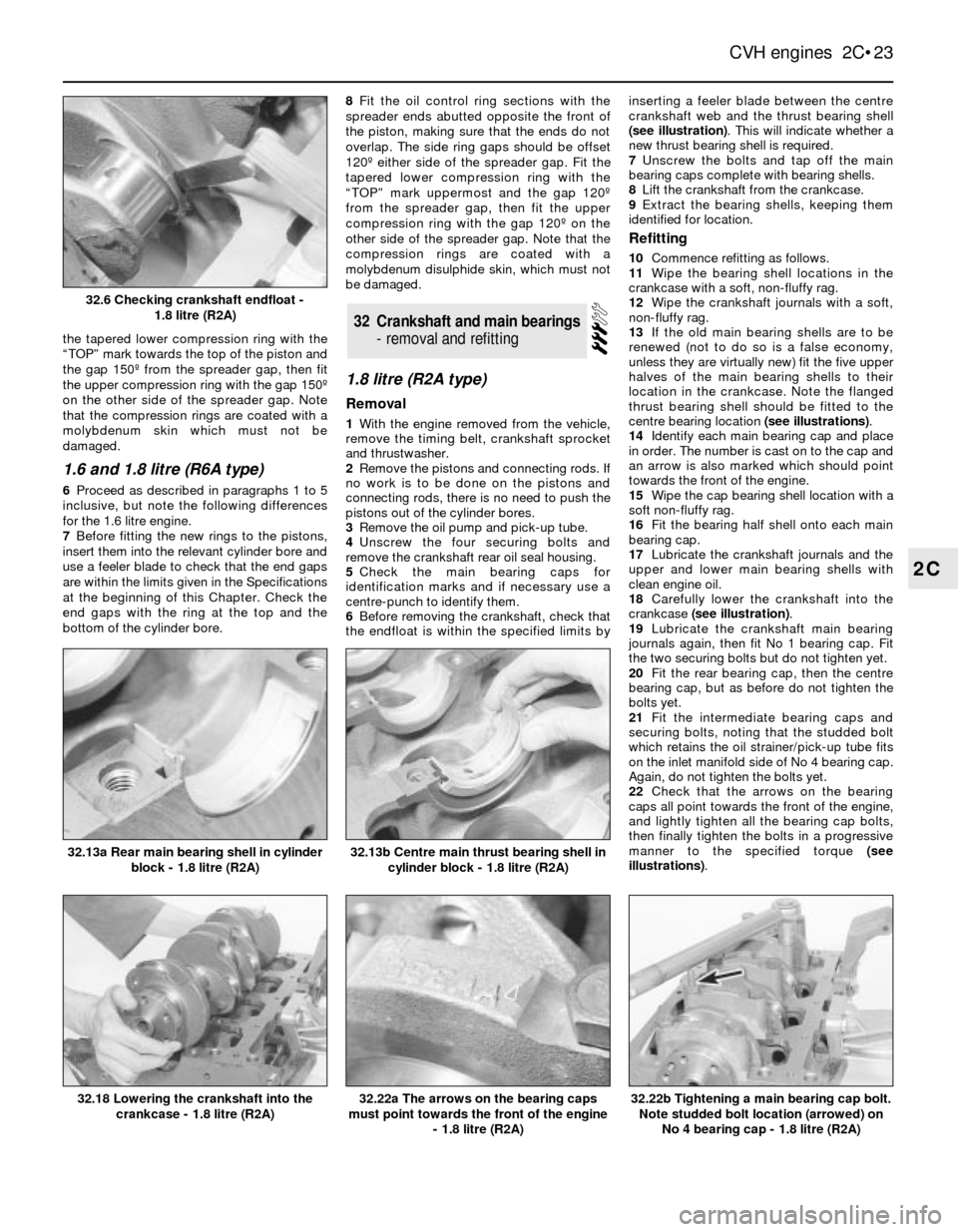
the tapered lower compression ring with the
“TOP” mark towards the top of the piston and
the gap 150º from the spreader gap, then fit
the upper compression ring with the gap 150º
on the other side of the spreader gap. Note
that the compression rings are coated with a
molybdenum skin which must not be
damaged.
1.6 and 1.8 litre (R6A type)
6Proceed as described in paragraphs 1 to 5
inclusive, but note the following differences
for the 1.6 litre engine.
7Before fitting the new rings to the pistons,
insert them into the relevant cylinder bore and
use a feeler blade to check that the end gaps
are within the limits given in the Specifications
at the beginning of this Chapter. Check the
end gaps with the ring at the top and the
bottom of the cylinder bore.8Fit the oil control ring sections with the
spreader ends abutted opposite the front of
the piston, making sure that the ends do not
overlap. The side ring gaps should be offset
120º either side of the spreader gap. Fit the
tapered lower compression ring with the
“TOP” mark uppermost and the gap 120º
from the spreader gap, then fit the upper
compression ring with the gap 120º on the
other side of the spreader gap. Note that the
compression rings are coated with a
molybdenum disulphide skin, which must not
be damaged.
1.8 litre (R2A type)
Removal
1With the engine removed from the vehicle,
remove the timing belt, crankshaft sprocket
and thrustwasher.
2Remove the pistons and connecting rods. If
no work is to be done on the pistons and
connecting rods, there is no need to push the
pistons out of the cylinder bores.
3Remove the oil pump and pick-up tube.
4Unscrew the four securing bolts and
remove the crankshaft rear oil seal housing.
5Check the main bearing caps for
identification marks and if necessary use a
centre-punch to identify them.
6Before removing the crankshaft, check that
the endfloat is within the specified limits byinserting a feeler blade between the centre
crankshaft web and the thrust bearing shell
(see illustration). This will indicate whether a
new thrust bearing shell is required.
7Unscrew the bolts and tap off the main
bearing caps complete with bearing shells.
8Lift the crankshaft from the crankcase.
9Extract the bearing shells, keeping them
identified for location.
Refitting
10Commence refitting as follows.
11Wipe the bearing shell locations in the
crankcase with a soft, non-fluffy rag.
12Wipe the crankshaft journals with a soft,
non-fluffy rag.
13If the old main bearing shells are to be
renewed (not to do so is a false economy,
unless they are virtually new) fit the five upper
halves of the main bearing shells to their
location in the crankcase. Note the flanged
thrust bearing shell should be fitted to the
centre bearing location (see illustrations).
14Identify each main bearing cap and place
in order. The number is cast on to the cap and
an arrow is also marked which should point
towards the front of the engine.
15Wipe the cap bearing shell location with a
soft non-fluffy rag.
16Fit the bearing half shell onto each main
bearing cap.
17Lubricate the crankshaft journals and the
upper and lower main bearing shells with
clean engine oil.
18Carefully lower the crankshaft into the
crankcase (see illustration).
19Lubricate the crankshaft main bearing
journals again, then fit No 1 bearing cap. Fit
the two securing bolts but do not tighten yet.
20Fit the rear bearing cap, then the centre
bearing cap, but as before do not tighten the
bolts yet.
21Fit the intermediate bearing caps and
securing bolts, noting that the studded bolt
which retains the oil strainer/pick-up tube fits
on the inlet manifold side of No 4 bearing cap.
Again, do not tighten the bolts yet.
22Check that the arrows on the bearing
caps all point towards the front of the engine,
and lightly tighten all the bearing cap bolts,
then finally tighten the bolts in a progressive
manner to the specified torque (see
illustrations).
32Crankshaft and main bearings
- removal and refitting
CVH engines 2C•23
2C
32.13b Centre main thrust bearing shell in
cylinder block - 1.8 litre (R2A)
32.22b Tightening a main bearing cap bolt.
Note studded bolt location (arrowed) on
No 4 bearing cap - 1.8 litre (R2A)32.22a The arrows on the bearing caps
must point towards the front of the engine
- 1.8 litre (R2A)32.18 Lowering the crankshaft into the
crankcase - 1.8 litre (R2A)
32.13a Rear main bearing shell in cylinder
block - 1.8 litre (R2A)
32.6 Checking crankshaft endfloat -
1.8 litre (R2A)